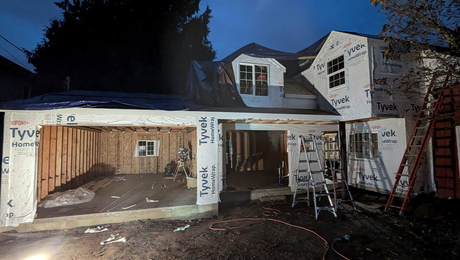I recently had a house inspection and they cited my water heater pressure relief valve as faulty. I called the inspector to find out how he tested it. It turns out he didn’t test it because he said that he ‘never opens the valve on water heaters because sometimes they’ll never shut off again. There was evidence of it leaking because the bottom of the tube had corrosion on it, so I cited it as faulty”.
Anyways, I don’t know anything about plumbing and the valve did leak last year for awhile but stopped at some point.
My question: should I just replace it or try to prove that it is functional?
My next question: If I replace it, is there anything I need to know, or should I just crank it off and put a new one on?
My plumbing history: Not good. I coulda made a three stooges episode when I changed the element in my last hot water heater.
Facts: I’ve got a gas hot water heater. It is installed too close to the furnace. I don’t know how it passed inspection. The place is a three years old condo that I recently sold.
blue















Replies
change it..
cake and pie..
Life is not a journey to the grave with the intention of arriving safely in a pretty and well preserved body, but rather to skid in broadside, thoroughly used up, totally worn out, and loudly proclaiming
WOW!!! What a Ride!
Forget the primal scream, just ROAR!!!
I'd probably just replace the thing. They're only about 10 bucks, I think. Not enough to be worth fighting over.
Is it going to cause a problem if it dribbles for a few days while you get around to changing it? If not, you can have a shot at testing.
Dan, I actually can't test it. The lever is so close to the furnace plenum that I can't flip it up to test it. I would if I could. If it leaks, then I'd change it.
If I change it, do I have to do anything special, like shut off the water?
blue
You'd damn well better shut off the water, unless you want an extended 110° shower.(-:
Politicians are the same the world over: they promise to build a bridge even when there is no river [Nikita Khrushchev]
That would definitely be interesting. By all means shut the feed water off. Then relieve the water pressure by flipping the valve. To bad you can't test it, but best to change it. Very simple procedure, just don't bust it out.
Very simple procedure, just don't bust it out.
Now you have me worried!
How do I "not bust it out"? I'm thinking I have to get a big wrench and twist the valve, but I don't have any way to get inside and stabilize whatever's in there.
This seems more complicated than framing an irregular roof with multiple planes, multiple heel heights and wandering wall heights.
blue
I've had success in the past with old pipe fittings be actually trying to tighten it just a little to get it moving. then try backing it out.
If it breaks in the tank you may be able to get the remainder out by tapping the piece away from the threads (picture making the hole smaller). Once the piece is folded in you should be abe to remove it. But lets not think about that now. It'll come out no problem (just keep telling yourself that the whole time your doing it).
When I said bust it out I was referring to the typical "grab the cheater bar and give it a turn...lol! I know they can be tight and in tough positions but they are actually easy to change.
If it won't turn easily, use a small pipe wrench and tap on the end with a hammer. The jarring generally breaks the corroded threads. If the water is off, lift the valve and let it bleed just enough to work.
or tighten it a little bit 1st...
tapping might break something...
Life is not a journey to the grave with the intention of arriving safely in a pretty and well preserved body, but rather to skid in broadside, thoroughly used up, totally worn out, and loudly proclaiming<!----><!----><!---->
WOW!!! What a Ride!<!----><!---->
Forget the primal scream, just ROAR!!!
This is true. I have installed hundreds and it never ceases to amaze me the lengths people will go to install or remove a tapered fitting. The "grab a bigger wrench" theory is so prevalent!
Nevertheless, tapping gently almost always works if someone has wrenched it pretty good. Even those lovable factory lugs!
like if Blue opens that drain valve....
if it won't close and he has to change it and it's plastic... and it snaps off...
hope he has an internal pipe wrench...
Life is not a journey to the grave with the intention of arriving safely in a pretty and well preserved body, but rather to skid in broadside, thoroughly used up, totally worn out, and loudly proclaiming<!----><!----><!---->
WOW!!! What a Ride!<!----><!---->
Forget the primal scream, just ROAR!!!
Replaced my drain valve a week ago.
1) Turn off gas valve ( or electric breaker)
2) Run hot water in sink or somewhere to get heater and contents cooled off.
3) Turn off cold water inlet
4) Drain out water
5) Replace safety valve
6) replace drain valve ( my suggestion, use a ball valve and add a hose connection for easier flushing.) This plastic POS on all heaters should be outlawed.
7) Re-open water inlet, be sure to close hot water valve in sink. don't ask.
8) re-open an re-light gas.
It's not often that I can contribute but I try to when I can. Hope this helps. Its pretty simple and use lots of pipe dope on fittings.
Long time lurker, new profile
Lefty, your list seems right for the drain valve, but I'm working on top of the water heater. I'm thinking that I don't need to drain it. Am I off track?
blue
You will need to drain only enough to get it below the vent valve level but if you're going to all that trouble, the drain valve is a piece of cake to change and if it leaks after you finish the vent, or if it breaks off like mine did, you will have a 10 min. panic to get it under control.
My drain valve was leaking a little at the threads, we had cooled the tank and were getting the garden hose ready to drain the heater, no water shut off yet. The drain broke off clean and they can fill laundry room floor in a hurry under pressure.
Just a suggestion. Good luck. I still hate plumbing but I did stay at a Holiday Inn Express one time. <g>
Long time lurker, new profile
shut the heater down..
shut off the water to it and let off the pressure...
unscrew it...
pipe dope the new one and screw it in...
hook up the drain line..
turn the water on...
go to a faucet some place in the air and bleed off the air.. let the hot water flow fer a bit...
relight the heater and yur good to go...
Life is not a journey to the grave with the intention of arriving safely in a pretty and well preserved body, but rather to skid in broadside, thoroughly used up, totally worn out, and loudly proclaiming<!----><!----><!---->
WOW!!! What a Ride!<!----><!---->
Forget the primal scream, just ROAR!!!
Imerc, it sounds so simple that I will try to do that.....after I get back from my weekend duck missing excursion. I can't find my camera to take a picture of the situation. It's pathetic. I can't believe that the plumbing and heating guys would place the two together so closely. There is plenty of room in the closet to space them out a foot or more, but they chose to put them so close that the lever hits the ductwork.
RJW, Before I do anything, I'm placing a call to the original plumbing and heating contractor and asking them if they'll come over and explain how/why they installed the units so close. I already tried to move them a 1/4 " or so and they didn't budge. I'd have to re do the gas line and supply lines to get more room. I'm thinking that this might be a health and safety violation and am hoping the contractor has enough character to take care of business.
I shoulda hired a home inspector before I moved in...
blue
DO NOT change or open the drain valve unless you have spare worm cans..
drain off as much is needed using the T&P valve before ya change it....
rag the installerd and get them to deal with it...
Life is not a journey to the grave with the intention of arriving safely in a pretty and well preserved body, but rather to skid in broadside, thoroughly used up, totally worn out, and loudly proclaiming<!----><!----><!---->
WOW!!! What a Ride!<!----><!---->
Forget the primal scream, just ROAR!!!
He did mention changing the T&P valve, but you kinda had to look for it.The reason for changing the drain valve is that there's a chance that, once it's opened, it won't close again either. This is less likely than the similar problem with the T&P valve, but not uncommon.On the other hand, totally draining the tank takes a long time, and removing the drain valve and it's nipple can be even more challenging than removing the T&P valve.
If Tyranny and Oppression come to this land, it will be in the guise of fighting a foreign enemy. --James Madison
You need to drain it below the valve.
Different jurisdictions have different requirements (and/or enforcement) of the "above a drain" / "outside" rules
Youth and Enthusiasm Are No Match
For Age and Treachery
If you're only doing the T&P, then you only need to drain enough to keep water from coming out of the hole at you.
The other thing you have to consider is whether the supply valve really shuts off all the way, or does it let a little thru? Draining a couple extra gallons may be enough to get the job done before the leakage by the supply valve makes a mess for you. If it's really bad, you may want to leave the hot running a little in the sink the whole time.
Opening the bottom drain valve once a year to get the crud out is a good idea. Replacing the crappy plastic drain valve with a good one makes that safer and easier. So, as long as you're messing with the W/H, consider doing all that at the same time.
BTW, how old is the heater itself? Maybe swap it out now, so it doesn't crap out on you in the dead of winter? Is there an expansion tank in the system? That'll take care of those pressure spikes that may make the T&P dribble. We can always think of more ways to spend your time and money.... ;-)
-- J.S.
but I'm working on top of the water heater. I'm thinking that I don't need to drain it. Am I off track?
Yeah, a little bit. The relief valve on top (no mandated to be on the sides) is more properly called a "TP" valve, as it is designed to relieve either pressure or temperature exceeding the WH's specs. The drain lines from a TPV are copper for that very reason (running 180+º water can be tough on PVC).
Unless, of course, you are in a jurisdiction that does not require a drain line from the TPV.
However, since it's a valve that "sets," you will need to darain the tank at least some amount just to get it out. (If it's on the side, you for sure want the tank drained to that level, unless you like mopping.)
Given your description of "too close" to the furnace, I'm actually guessing that closign the CW at the cut off, and draining the DHW will be to your advantage. That's because, with the CW supply loose, and the tank mostly empty, you ought to be able to give it enough of a turn to rotate the TPV to a better spot.
However, if this is a gas heater, make sure that turn does not obscure the gas/pilot contorl, or the pilot inspection window (don't ask).
Hope that has not made it clear as mud.Occupational hazard of my occupation not being around (sorry Bubba)
If it's that cramped you're gonna have fits changing it. The valve has a temperature sensor that extends about 6 inches into the tank. Practically speaking you need about 10 inches of clearance above the valve (if mounted vertically) and 18-24" around it to swing a wrench. You may need to remove the duct if it's that tight.The water supplying the water heater needs to be turned off. Also turn off the water heater heat (flip breaker or turn gas valve to "pilot" or whatever) so you don't have problems with thermal expansion. Open the lowest hot water faucet in the house to relieve pressure, then drain a couple of gallons from the heater drain valve. (Caution, the water will be VERY HOT!)Or call a plumber.
If Tyranny and Oppression come to this land, it will be in the guise of fighting a foreign enemy. --James Madison
note: here the pop off valve has to be plumbed to outside.
Can you pop the flue off the WH and rotate it to get better access away from the duct?
Ithaca, NY "10 square miles, surrounded by reality"
Emory cloth the rust and drips off the offending pipe. Then clean all around the waterheaters sensor. You might even install a waterheater blanket.
All this so it looks like you replaced the sensor and even got a new waterheater. Have 6 or so Killians Red beer icing in a 5 gallon bucket in the path to the waterheater. Put on some music like the sounds of a NASCAR race in the background.
Invite him for a late afternoon inspection......yuck! I gross myself out
FWIW, I don't call out a situation like that as "defective.".
In fact, to me, the drip marks/corrosion indicate the opposite: that it is working as intended
It is not unusual for there to be a pressure surge in municipal systems and/or water heater temps which cause the valves to open briefly
If you can't trip the valve because of its location, you're going to have to shift the water heater to replace it.
FWIW: HI's don't test 'em for the reason he gave.
Neither do any plumbers I know, even though the tag on the T/P valves call for them to be checked by a plumber every 3 years.
Youth and Enthusiasm Are No Match
For Age and Treachery
Leave the valve alone and change the drip tube.
"When asked if you can do something, tell'em "Why certainly I can", then get busy and find a way to do it." T. Roosevelt
They don't call you Fast Eddie for nothing!
If Tyranny and Oppression come to this land, it will be in the guise of fighting a foreign enemy. --James Madison
I'd change it. The problem is that if its not opened up regularly it could have corrosion built up on it and if you open it now, it may not shut off completely.
Kind of like sink shutoffs and breakers (both, i've been told should be turned on and off yearly).
Bloody DIYers. Call a pro, will ya?? ;-)
Tongue firmly in cheek...
Maybe someday I'll know a little something.
Leave it alone. Theres nothing wrong with it. Tell them to call the inspector and ask why it is labeled as faulty when it was never tested. They all drip a little every now and then. Could even be condensation collecting on or in the line.